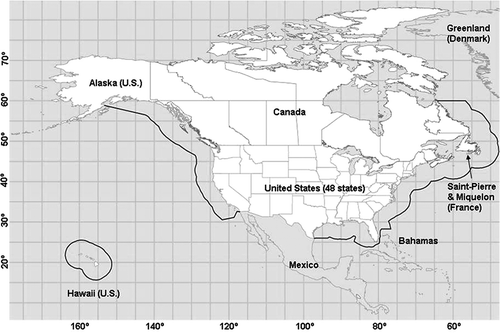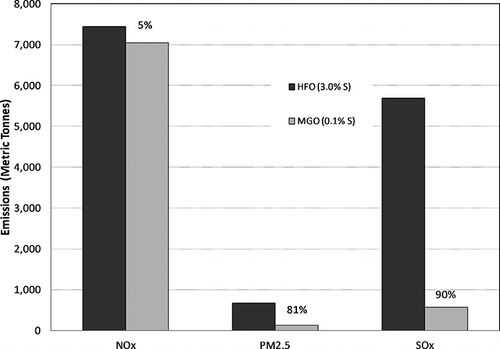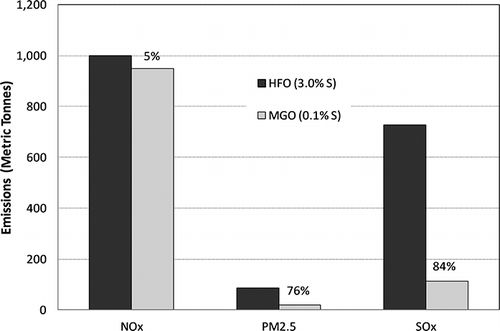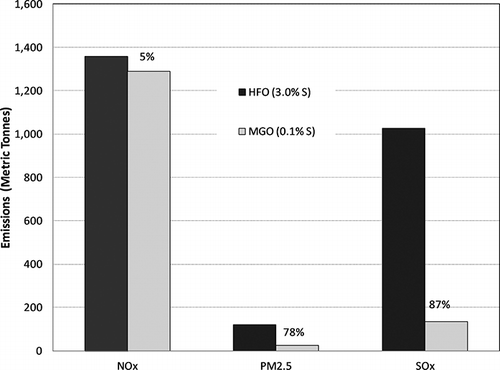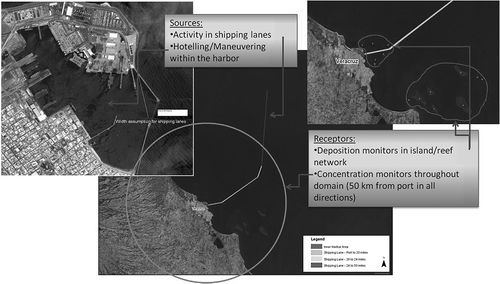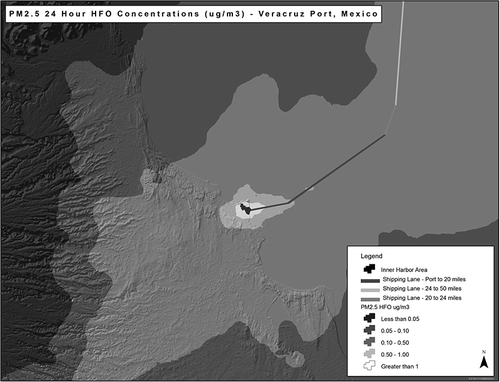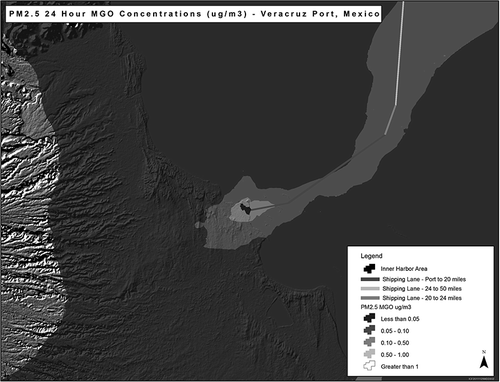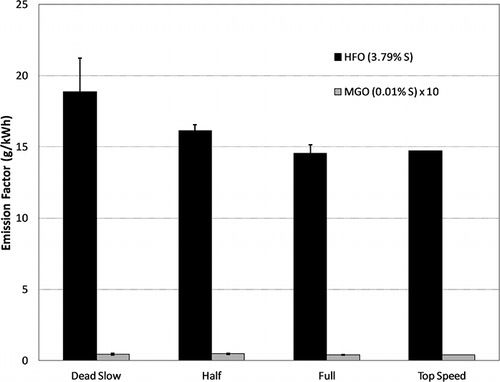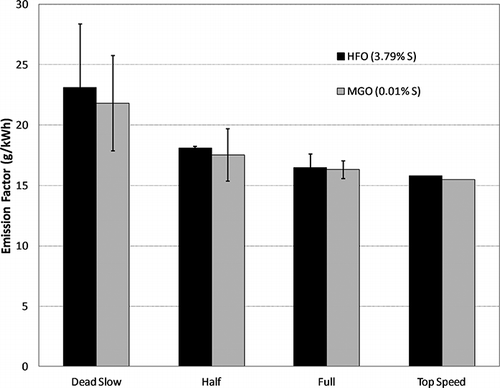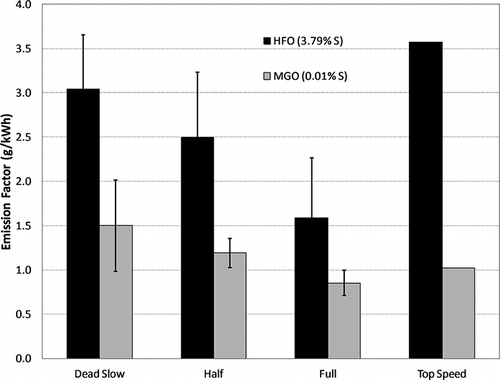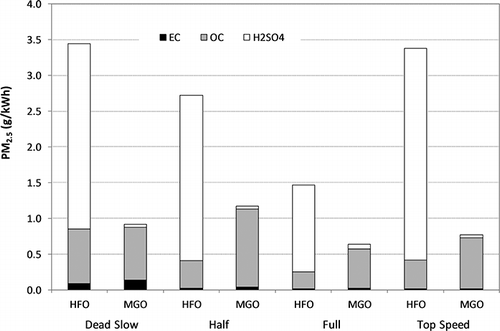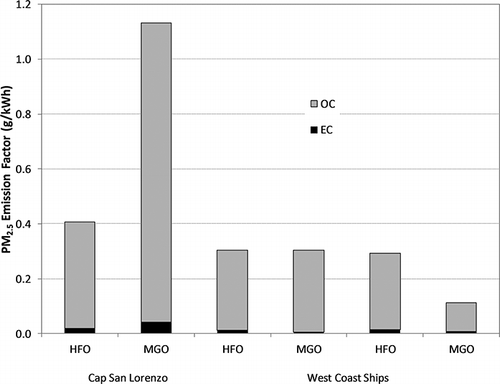Abstract
Switching fuels from high-sulfur heavy fuel oils (HFO) to lower sulfur marine gas oils (MGO) on an oceangoing vessel (OGV) can substantially reduce both PM and SOx ship stack emissions, potentially resulting in significant human health and environmental benefits in Gulf of Mexico port communities. The International Maritime Organization (IMO) established an emission control area (ECA) within 200 nautical miles of the U.S. and Canadian coastlines and French territories off the coast of Canada with lower fuel sulfur standards effective beginning August 2012, where OGVs will need to switch from HFO to MGO. However, some operators and other stakeholders, particularly in the Gulf of Mexico, may be unfamiliar with the benefits and requirements and ship operators may be concerned over potential implications for cost and operations. This first-ever U.S. Environmental Protection Agency (EPA)-sponsored fuel switching demonstration in the Gulf of Mexico was initiated to showcase the environmental and health benefits of, as well as operational issues associated with, fuel switching through the following activities: (1) Fuel switching was conducted on typical container ships operating the Gulf of Mexico, as routine fuel switching has been demonstrated in California in recent years. Two vessels were employed in the demonstration: the Maersk Roubaix, which switched fuels entering Port of Houston, TX, and the Port of Progreso, Mexico, and the Hamburg Süd vessel Cap San Lorenzo, which switched fuels entering the Port of Houston and the Mexican Ports of Veracruz and Altamira. Operational and cost aspects were also noted. (2) Emissions reductions were quantified through both a calculation approach based on fuel use of the Maersk Line vessel Roubaix and in-stack monitoring of emissions from the Hamburg Süd Cap San Lorenzo. Pollutant emissions including PM, SOx, NOx, and PM component speciation were sampled during use of both fuels. These observations showed reductions (1–6%) in NOx and substantial reductions in PM (50–70%) and SOx (>99%) depending on engine and load. (3) Emission inventories at three ports were calculated. (4) Potential health and environmental benefits to communities and ecosystems in the Gulf of Mexico were estimated through screening-level modeling of air dispersion and atmospheric deposition of ship emissions at the Port of Veracruz to indicate the substantial reductions available through fuel switching.
The United States and Canada have recently adopted a North American Emission Control Area that will require a shift from high-sulfur to low-sulfur fuels in the marine transportation sector. Cleaner fuels are expected to reduce sulfur and particulate emissions. This paper verifies the feasibility of such switching operations, the potential to reduce emissions if extended to the Gulf of Mexico, and the associated environmental impacts of these emission reductions inland and to sensitive ecosystems.
Introduction
Oceangoing vessels (OGVs) are used to transport the majority of goods globally, a majority measured in terms of both weight and value. These vessels are a significant source of air pollution, affecting populations and ecosystems especially near coastal areas. (CitationCorbett et al., 2007; CitationDalsøren et al., 2009). U.S. Environmental Protection Agency (EPA) modeling also shows potential impacts far inland (CitationU.S. EPA, 2007) .This project focused on the impact of OGV emissions at selected ports in the Gulf of Mexico, as routine fuel switching has been demonstrated in California in recent years (CitationMaersk, 2010). One method of significantly reducing emissions from OGVs is to switch from a high-sulfur marine heavy fuel oil (HFO) (also known as bunker fuel or residual oil) to lower sulfur marine gas oil (MGO) (also known as marine distillate fuel or marine gas oil). Switching from HFO to MGO can dramatically reduce ship particulate matter (PM2.5) and sulfur oxides (SOx) emissions, as well as achieving some reductions in nitrous oxide (NOx) emissions. These and other pollutants emitted from ships are related to human health and environmental impacts, including asthma, increased cancer risk, and regional haze/smog (CitationU.S. EPA, 2007), and, via atmospheric deposition to water, they contribute to acidification and hypoxia, particularly in coastal areas (CitationDoney et.al.,2007).
In March 2010 the International Maritime Organization under the International Convention for the Prevention of Pollution from Ships Annex VI, Prevention of Air Pollution from Ships (MAROPL Annex VI), established an emission control area (ECA) within 200 nautical miles of the U.S. and Canadian coastlines and French territories off the coast of Canada (see ). MARPOL Annex VI puts in place lower sulfur marine fuel standards and other requirements, as described in , which became enforceable on August 1, 2012, within the North American ECA (hereafter NA ECA).
Table 1. International ship engine and fuel standards (MARPOL Annex VI)
This multinational project aimed to raise awareness throughout the Gulf of Mexico about the environmental and human health benefits, as well as any operational issues, associated with implementing lower sulfur fuel content requirements, such as the NA ECA fuel standard requiring the use of 0.1% fuel sulfur by 2015. The fuel switching demonstration design differed from the NA ECA requirements, in that the fuel switching boundary chosen for the demonstration was 24 nautical miles (nm) offshore instead of 200 nm. This was because the NA ECA distances had not been determined at the start of this project and 24 nm was consistent with what the Air Resources Board was requiring in California.
This project monitored ship stack emissions and modeled air quality impacts resulting from fuel switches from HFO to MGO on ships approaching the U.S. and Mexican Gulf coasts. The Port of Houston and three key Gulf Ports in Mexico—Progreso, Alta Mira, and Veracruz—were targeted. Additional information on this project is available on the U.S. EPA U.S.–Mexico fuel switching demonstration website, http://www.epa.gov/international/fuelswitch.html, and in the final report (CitationU.S. EPA, 2010) for this project. The methodology used for all emission calculations for the development of port emission inventories can be found in the U.S. EPA report “Current Methodologies in Preparing Mobile Source Port Related Emission Inventories” (CitationICF International, 2009).
Benefits of Fuel Switching at Select Ports
Fuel switching can produce significant emission reductions in coastal areas, with potentially significant health and environmental benefits. To quantify these reductions in the Gulf of Mexico, port emission inventories were developed for the Port of Houston and the Mexican ports of Alta Mira and Veracruz. In addition, air dispersion modeling of vessel-related PM and SOx emissions was conducted at the Port of Veracruz to indicate the potential reduction in ambient pollution concentrations in the vicinity of the city of Veracruz and deposition to adjacent, ecologically sensitive marine areas (reefs).
Port emission inventories
Emission inventories for ships calling on three ports were developed using vessel port call data together with Lloyd's Register of Ships data. Emissions were estimated for ships operating on HFO, with an assumed sulfur content of 3.0% (consistent with what SEMARNAT used in their inventories), and MGO, with a sulfur content of 0.1%. As noted later, these fuel sulfur contents are reasonably consistent with the measured fuel sulfur in the fuel switching demonstration. All emission and load factors used came from the U.S. EPA Current Methodologies document (CitationICF International, 2009).
Methodology Overview
The most widely used practice to calculate emissions from OGVs is to use energy-based emission factors together with activity profiles for each vessel. The emission factor is expressed in terms of emissions per unit of energy from the engine; emissions are the product of the emission factor and the power needed to move the ship in a particular activity. The bulk of the work involves determining representative engine power ratings for each vessel and the development of activity profiles for each ship call. Using this information, emissions per ship call and mode can be determined using the equation
where E is the emissions (grams [g]), P the maximum continuous rating power (kilowatts [kW]), LF the load factor (percent of vessel's total power), A the activity (hours [hr]), and EF the emission factor (grams per kilowatt-hour [g/kWh]).
Fuel type also is instrumental in determining emission factors and fuel use patterns should be determined for each port. This study assumes as a baseline that all OGVs operate their main propulsion and auxiliary engines on heavy fuel oil (HFO). It also assumed that both the main and auxiliary engines begin and complete the switch from HFO to marine gas oil (MGO) from ½ to 1 hour before they reach 24 nautical miles (nm) from the coastline, as shown in . This is because the switch to a different type of fuel is done slowly to minimize thermal shocks to the fueling system. Thus, it needs to be started prior to reaching the 24-nm boundary. Fuel switching times are estimated based upon total ship propulsion power.
Table 2. Fuel switching times
Estimating ship activity during a typical port call is best accomplished by breaking down the call into sections that have similar speed characteristics. Unlike the highly transient nature of on-road vehicles, ships operate at a number of steady-state modes, so vessel movements for each call can be described by using five distinct time-in-mode calculations. A call combines all modes. Each time-in-mode is associated with a speed and, therefore, an engine load that has unique emission characteristics. While there will be variability in each vessel's movements within a call, these times-in-mode allow an average description of vessel movements at each port. Times-in-mode should be calculated for each vessel call occurring in the analysis year over the waterway area near the port. The times-in-mode are described in .
Table 3. Vessel movements and time-in-mode descriptions
Load factors are expressed as a percent of the vessel's total propulsion or auxiliary power. At service or cruise speed, the propulsion load factor is assumed to be 83%. At lower speeds, the Propeller Law should be used to estimate ship propulsion loads, based on the theory that propulsion power varies by the cube of speed as shown in this equation:
Load factors for auxiliary engines vary by ship type and time-in-mode. Auxiliary engines are generally running all of the time, with the largest loads occurring during hotelling. Auxiliary engine load factors as well as emission factors for both propulsion and auxiliary engines can be found in the “Current Methodologies in Preparing Mobile Source Port Related Emission Inventories” document (CitationICF International, 2009).
Port of Houston, USA
Emissions from ships operating on HFO and MGO were calculated for 2007 assuming all ships entering or leaving the Port of Houston used that fuel within 24 nm of the U.S. coastline. Fuel switching was assumed to be complete prior to the 24-nm boundary.
Comparisons of port emissions for various fuel types at the Port of Houston are shown in . Using these methods, NOx emissions are predicted to be reduced by 5%, PM2.5 by 81%, and SOx by 90% by switching from HFO to MGO within 24 nm of port. This would amount to 402 metric tonnes of NOx, 544 metric tonnes of PM2.5, and 5,116 metric tonnes of SOx per year, at 2007 activity levels, if all vessels were to undergo such a fuel switch.
Port of Alta Mira, Mexico
Emissions on HFO and MGO were calculated for 2005 assuming all ships entering or leaving the Port of Alta Mira used that fuel within 24 nm of the Mexican coastline. The general methodology was as already described with the following differences: There was no transit zone (like the Houston ship channel) at the Port of Alta Mira, and only 2005 ship call data were available for the Mexican ports. In addition, typical hotelling and maneuvering times were shorter than for Houston.
shows comparisons of port emissions for the Port of Alta Mira. Using the methods and data documented earlier, we estimate a potential NOx emission reduction of 6%, PM2.5 reduction of 76%, and SOx reduction of 84% to be achievable by switching from HFO to MGO within 24 nm of port. These reductions would imply a reduction potential of 51 metric tonnes of NOx, 66 metric tonnes of PM2.5, and 615 metric tonnes of SOx should all vessels undergo such fuel switching operation. These emissions reductions are lower than those for the Port of Houston, due principally to the fact that total annual calls at the Port of Alta Mira were roughly 20% of that at the Port of Houston (1,138 compared to 5,778 annual calls), although other activity metrics also differ.
Port of Veracruz, Mexico
Annual emissions for ships operating on both HFO and MGO were also calculated for 2005 level activity for the Port of Veracruz assuming all ships entering or leaving completed their fuel switch beyond 24 nm of the Mexican coastline. Again, maneuvering and hotelling times typical of Veracruz were used. Typical hotelling times were longer for Veracruz than for either Alta Mira or Houston.
Comparisons of port emissions for Port of Alta Mira are shown in . As shown in the figure, NOx emission reduction potential is estimated at 6%, PM2.5 at 78%, and SOx at 87% for switching from HFO to MGO within 24 nm of port. This would amount to 70 metric tonnes of NOx, 94 metric tonnes of PM2.5, and 892 metric tonnes of SOx should all vessels switch from HFO to MGO. As for Alta Mira, these comparatively lower emissions reductions are principally due to the lower total annual number of calls at the Port of Veracruz (1,446 compared with 5,778 calls at the Port of Houston).
Dispersion Modeling
In order to perform a screening-level assessment of health and ecosystem benefits associated with fuel switching at a port in Mexico, the emissions calculations just presented were used in a dispersion study at the Port of Veracruz to estimate potential air concentration impacts of key pollutants and their deposition impacts on a key sensitive ecosystem area: the nearby coral reefs that are within a designated Mexican National Sea Park area.
Methodology overview
All modeling was conducted using the U.S. EPA AERMOD model (CitationU.S. EPA, 2009). Obtaining the necessary meteorological data for the AERMOD model required contacting numerous sources within various U.S. and Mexican agencies. No agency was able to provide all required fields or for an extended duration, so ultimately, various sources were compiled to create a single meteorological record providing one year of relevant meteorological data from February 2008 through February 2009. These data were appropriate for this screening-level assessment and indicate a dominant wind direction from the northeast, which is an onshore direction for Veracruz.
The annual emissions from all vessels calling on the Port of Veracruz during calendar year 2005, assuming a uniform temporal profile, were used to estimate the pollutant concentration reductions achievable. A domain with a radius of 50 km from the harbor area was characterized with the model. The port and ship channel were modeled as a series of area sources. This was done by mapping the four operating modes to four operating areas. A network of virtual receptors was assigned in a radius of 50 km from the harbor area and at the reef and island network near the harbor to characterize deposition to those areas. shows the modeling domain, including the various source and receptor locations. All receptors were located at a breathing height of 1.8 m. Local terrain effects on the dispersion calculations were also included. Effects of both dry and wet removal of both gas and particulate pollutants was considered. Results were characterized in terms of design values defined relative to the official standards for air quality in Mexico, “NORMA Oficial Mexicana” (CitationSEMARNAT, 2009), which are very similar to the U.S. National Ambient Air Quality Standards (NAAQS).
Results
shows the resulting values of PM2.5 for the 98th percentile of all 24-hr average concentrations over the course of the modeled year reported at each receptor location when operating on HFO. shows similar PM2.5 values, but with all ships undergoing fuel switching.
Comparison of and shows how concentrations may be reduced when moving from operations under a traditional approach (using only HFO fuel) to that of a fuel switching approach (i.e., use of 0.1% sulfur MGO within 24 nm of shore). Similar trends were seen in annual average PM2.5, while even more dramatic reductions were seen for both long- and short-term average SO2 concentrations.
Note that the concentrations shown here include only emissions from ships. For comparison to air quality standards, all background concentrations, including those caused by emissions from all other activities at the port as well as all other regional activities, would also need to be added to these values. However, these modeling results provide a first look at the potential impact of ship emissions on human health in coastal areas and on sensitive ecosystems.
Deposition of pollutants from ship exhaust can also impact sensitive ecosystems, including areas of natural productivity, critical habitats, and areas of cultural and scientific significance. The same dispersion modeling discussed earlier was also used to estimate the reduction in deposition of sulfur (as SO2) to the local waters of the Gulf of Mexico. This deposition includes sulfur from both dry and wet settling of SO2 from ship exhaust. shows the receptors established to characterize the impact to the island and reef network off the coast of Veracruz. tabulates the total deposition to each of the areas in each case under the assumption that all vessels entering the Port of Veracruz either switched from HFO to MGO within 24 nm of shore or operate solely on HFO.
Table 4. Estimated annual total deposition of SO2
These results indicate that about 52,000 kg (or 96% of the baseline value) of sulfur deposition (as SO2) could be avoided to the reef and island network surrounding Veracruz if all vessels calling on the port were to move to a fuel switching regime within 24 nm of shore.
Fuel Switching Demonstrations
Two shipping companies (Maersk Line and Hamburg Süd) partnered with the U.S. EPA to demonstrate fuel switching on two container ships which regularly travel between the Port of Houston and Gulf ports in Mexico. The first fuel switch demonstration was conducted on the Maersk vessel Roubaix in November 2009. Emissions reductions were estimated based on the amount of fuel used. The second fuel switching demonstration was conducted on the Hamburg Süd vessel Cap San Lorenzo in April 2010. Actual emissions reductions were obtained based on stack emission monitoring. This paper focuses on the results of the second demonstration.
The Cap San Lorenzo (IMO 9215684) is a 3,739-TEU container ship. Fuel switches were conducted while at the ports of Veracruz, Alta Mira, and Houston from April 15 to 20, 2010.
Emission sampling methodology
During the Cap San Lorenzo voyage from Veracruz to Houston, stack emissions from both the main and auxiliary engines were measured while operating on MGO and HFO at several engine loads and speeds. In addition, emissions were measured while the vessel switched fuels. The methods for sampling and analysis of the gases and particulate matter (PM2.5) conformed to the requirements of ISO 8178-1. Fuel quality testing was also performed on both the residual and distillate marine fuels. Certifications were obtained for both fuels, which showed 3.79% sulfur for the HFO and 0.01% sulfur for the MGO. These values are similar to the assumed values in the emissions calculations (described earlier), though the MGO fuel sulfur level is much lower than will be required by the NA ECA.
The concentrations of CO2 and NOx were measured in the raw exhaust gas and diluted gas streams using an exhaust gas analyzer. PM2.5 was measured both continuously using a Nephelometer (TSI DustTrak 8520) and during specified speed and load points with discrete filter samples. The PM2.5 mass was fractioned into sulfate and elemental plus organic carbon in order to determine the composition of the mass. In the second measurement approach, a quartz filter captured the PM emissions from the same sample line used for the Teflon PM mass determination. The quartz filter was postprocessed at the University of California, Riverside (UCR) lab so as to identify the fraction of the PM mass that is organic and elemental carbon (OC + EC). Emissions were tested both at the specified load points for the ISO testing, and at loads representing the four vessel in-use operating modes (top speed, full speed, half speed, and dead slow). Emissions were sampled from both main and auxiliary engines. More details on sampling methods can be found in the fuel switching report (CitationU.S. EPA, 2010).
Emission sampling results
SO2 emissions at the various load points in Veracruz and Houston show a 99.7% reduction in SO2 emissions as a result of fuel switching across all loads and speeds (). Note that the SO2 emissions for MGO are multiplied by 10 in the figure to be visible. NOx emissions at the various load points show a small reduction as a result of fuel switching and were dependant on speed (values of 1 to 6% reduction were observed, although these magnitudes are not statistically significant) (). PM2.5 emissions at the various load points show a 47% to 71% reduction due to fuel switching (). Speciated PM emission results show a significant decrease in sulfates (H2SO4) as expected. These findings are similar to those found by ENTEC in a larger study (CitationENTEC, 2002). However, OC emissions tended to increase from fuel switching, particularly at half speed (). Auxiliary engines showed similar results to the propulsion engine results in all cases. Error bars shown in the figures represent the 95% confidence interval for the measurements.
The OC emission result is unexpected. Hamburg Süd engineers (CitationHarris, 2011) believe the observed increase was due to residual HFO adhering to the fuel system pipes and heaters after switching to MGO. These deposits were picked up by the MGO, as this was the first time the vessel had switched fuels for any length of time, and did not burn as readily as the principal fuel. If this is the case, once the Cap San Lorenzo starts regular fuel switching as part of the NA ECA, the OC emissions when operating on MGO will be similar to that on HFO. This has been shown in other ships on the west coast that have been switching fuels frequently ().
Cost and operational issues
For the work performed during this study and along the test demonstration vessel route, the 0.01% MGO used was available only at the Port of Houston. The average sulfur level of the HFO available in Mexico was 3.8% (CitationSEMARNAT, 2010), which is higher than the global average, which is estimated to be 2.7%. According to the superintendent in charge of the Cap San Lorenzo (CitationHarris, 2011), the fuel switching process is simple and is part of normal engine operational procedures. No special training was needed for this demonstration. He reported that the Cap San Lorenzo’s engines and fuel supply systems ran normally during the fuel switching exercise and no difficulties were encountered. Tank capacity was sufficient to carry the needed lower sulfur fuel for the demonstration (300 metric tonnes capacity, 40 metric tonnes needed for the demonstration).
The Cap San Lorenzo switched fuels from HFO to MGO upon entering the Port of Veracruz (April 14, 2010), the Port of Alta Mira (April 15, 2010), and the Houston Ship Channel, where it docked at Barbour's Cut (April 20, 2010). For this voyage, a fuel cost increase of $10,171 was observed. This is approximately 14% of the voyage fuel costs for the round trip from Veracruz to Alta Mira to Houston and back to Veracruz.
Summary
This project demonstrated that fuel switching in the Gulf of Mexico can lead to large reductions in emissions of both PM and SOx, as calculated using U.S. EPA-approved methods and corroborated by observations through on-board emission sampling. Dispersion modeling showed that a large reduction in impacts to port area air quality and deposition to sensitive reefs in the Veracruz area could be achieved from fuel switching. With acknowledgment that this study has not quantified the effects of fuel switching on overall concentrations or deposition of air pollutants, the reductions of NOx, PM and SOx concentrations associated with fuel switching imply that similar results could be achieved in Mexico through reduced use of HFO fuel in shipping when approaching ports.
Emissions monitoring showed that switching to low-sulfur marine fuel achieved significant reductions in emissions of SOx and PM2.5—89 and 80% respectively—and small reductions of NOx at a 2% increase in vessel operating costs, due to the higher cost of lower sulfur fuel.
Ship emission inventories were developed for the ports of Houston, Veracruz, and Alta Mira using vessel port call data together with Lloyd's Register of Ships data. At all ports annual emissions reductions of NOx, PM, and SOx achieved through fuel switching within a 24-nm fuel switching zone were calculated. For the Port of Houston, PM and SOx reductions were 81 and 90%, respectively; for Alta Mira, PM and SOx reductions were 76 and 84%, respectively; and for Veracruz, PM and SOx reductions were 78 and 87%, respectively. In all cases, a 5% reduction in NOx was also observed, although the magnitude of this reduction is statistically insignificant.
Dispersion modeling was conducted for the Port of Veracruz using the calculated emission inventory. The modeling showed a large reduction in impacts of ship emissions on port area air quality and atmospheric deposition to nearby sensitive reefs is achievable from fuel switching within 24 nm of the port. Air quality modeling of the ship contribution to inventories showed a sevenfold reduction in 24-hr average and annual average PM2.5 concentrations and a 24- to 25-fold reduction in 24-hr average and annual average SO2 concentrations. This study has indicated that local concentrations of PM2.5 pollution from ships could be reduced as much as 43 to 88% over the entire modeling domain by moving to a fuel-switching mode for ships calling on the Port of Veracruz. Deposition modeling showed a 99% reduction of SO2 deposition to sensitive reef areas off the coast of Veracruz.
Acknowledgments
The authors would like to thank William Welch and James Gutierrez of University of California Riverside for performing the emission sampling on the Cap San Lorenzo, Peter Harris of Hamburg Süd for facilitating using the Cap San Lorenzo vessel, and Lee Kindberg of Maersk for facilitating using the Maersk Roubaix vessel for the fuel switching demonstrations.
References
- Corbett , J. , Winebrake , J. , Green , E. , Kasibhatla , P. , Eyring , V. and Lauer , A. 2007 . Mortality from ship emissions: a global assessment . Environ. Sci. Technol , 41 : 8512 – 8518 .
- Dalsøren , S. , Eide , M. , Endresen , O. , Mjelde , A. , Gravir , G. and Isaksen , I. 2009 . Update on emissions and environmental impacts from the international fleet of ships: the contribution from major ship types and ports . Atmos. Chem. Phys , 9 : 2171 – 2194 .
- Doney , S. C. 2007 . Impact of anthropogenic atmospheric nitrogen and sulfur deposition on ocean acidification and the inorganic carbon system . Proc. Natl. Acad. Sci. , 104 ( 37 ) : 14580 – 14585 .
- ENTEC. 2002. Quantification of Emissions from Ships Associated with Ship Movements between Ports in the European Community. Prepared for the European Commission, July http://ec.europa.eu/environment/air/quality/background.htm (http://ec.europa.eu/environment/air/quality/background.htm) (Accessed: 12 March 2012 ).
- Harris , P. 2011 . E-mail communication with Peter Harris, Technical Superintendent for Hamburg Süd, October 6. ,
- ICF International. 2009. Current Methodologies in Preparing Mobile Source Port Related Emission Inventories. Final Report. April http://www.epa.gov/sectors/sectorinfo/sectorprofiles/ports/ports-emission-inv-april09.pdf. (http://www.epa.gov/sectors/sectorinfo/sectorprofiles/ports/ports-emission-inv-april09.pdf.) (Accessed: 12 March 2012 ).
- Maersk . 2010 . Maersk Line's Fuel Switch Experiences in California Waters . Presentation by A.P. Moller-Maersk Group, Regulatory Affairs, Maersk Marine Technology, April 27. ,
- SEMARNAT. 2009. Normas Mexicanas de Calidad del Aire. http://www.ine.gob.mx/calaire-informacion-basica/559-calaire-nom-cal-aire (http://www.ine.gob.mx/calaire-informacion-basica/559-calaire-nom-cal-aire) (Accessed: 12 March 2012 ).
- SEMARNAT. 2010. Experiencias en México relacionadas con las emisiones de grandes buques. Presented in Veracruz, Mexico, on April 16 http://www.epa.gov/international/air/workshopreport/AnnexIII.pdf. (http://www.epa.gov/international/air/workshopreport/AnnexIII.pdf.) (Accessed: 12 March 2012 ).
- U.S. Environmental Protection Agency. 2007. U.S. Government Submittal to the 11th Session of the IMO's Subcommittee on Bulk Liquids and Gases: Air-Quality Concerns from Particulate Matter and Oxides of Sulphur. February 23 http://www.epa.gov/otaq/regs/nonroad/marine/ci/blg11-05-27-pm-sox-united-states.pdf (http://www.epa.gov/otaq/regs/nonroad/marine/ci/blg11-05-27-pm-sox-united-states.pdf) (Accessed: 16 March 2012 ).
- U.S. Environmental Protection Agency. 2009. AERMOD Implementation Guide. March http://www.epa.gov/ttn/scram/7thconf/aermod/aermod_implmtn_ guide_19March2009.pdf (http://www.epa.gov/ttn/scram/7thconf/aermod/aermod_implmtn_ guide_19March2009.pdf) (Accessed: 12 March 2012 ).
- U.S. Environmental Protection Agency. 2010. U.S.-Mexico Demonstration of Fuel Switching on Ocean Going Vessels in the Gulf of Mexico. EPA 160-R-10-001, December http://www.epa.gov/international/air/fuelswitchreport.pdf (http://www.epa.gov/international/air/fuelswitchreport.pdf) (Accessed: 12 March 2012 ).
